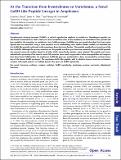Files in this item
At the transition from invertebrates to vertebrates a novel GnRH-like peptide emerges in amphioxus
Item metadata
| dc.contributor.author | Roch, Graeme | |
| dc.contributor.author | Tello, Javier | |
| dc.contributor.author | Sherwood, Nancy | |
| dc.date.accessioned | 2014-11-18T21:01:05Z | |
| dc.date.available | 2014-11-18T21:01:05Z | |
| dc.date.issued | 2014-04 | |
| dc.identifier | 86439811 | |
| dc.identifier | 26c22c98-fffe-47f3-96d4-f65a53ab177e | |
| dc.identifier | 84897891960 | |
| dc.identifier | 000333283200001 | |
| dc.identifier.citation | Roch , G , Tello , J & Sherwood , N 2014 , ' At the transition from invertebrates to vertebrates a novel GnRH-like peptide emerges in amphioxus ' , Molecular Biology and Evolution , vol. 31 , no. 4 , pp. 765-778 . https://doi.org/10.1093/molbev/mst269 | en |
| dc.identifier.issn | 0737-4038 | |
| dc.identifier.other | ORCID: /0000-0001-6637-2155/work/64034519 | |
| dc.identifier.uri | https://hdl.handle.net/10023/5792 | |
| dc.description | This work was supported by a grant from the Canadian Natural Sciences and Engineering Council (NSERC). | en |
| dc.description.abstract | Gonadotropin-releasing hormone (GnRH) is a critical reproductive regulator in vertebrates. Homologous peptides are also found in invertebrates, with a variety of characterized functions. In the amphioxus, an invertebrate that provides the best model for the transition to vertebrates, four GnRH receptors (GnRHRs) were previously described, but their native ligands were not identified. Using a more sensitive search methodology with hidden Markov models, we identified the first GnRH-like peptide confirmed in the amphioxus Branchiostoma floridae. This peptide specifically activated one of the four GnRHRs. Although the primary structure of this peptide was divergent from any previously isolated GnRH peptide, the minimal conserved residues found in all other GnRH superfamily members were retained. The peptide was immunolocalized in proximity of the central canal of the anterior nerve cord, a region where other neuropeptides and receptors have been found. Additionally, the amphioxus GnRH-like gene was positioned in a locus surrounded by syntenic homologs of the human GnRH paralogon. The amphioxus GnRH-like peptide, with its distinct primary structure, activated a receptor with equal potency to multiple ligands that span the GnRH superfamily. | |
| dc.format.extent | 1297862 | |
| dc.language.iso | eng | |
| dc.relation.ispartof | Molecular Biology and Evolution | en |
| dc.subject | Hormone evolution | en |
| dc.subject | Adipokinetic hormone | en |
| dc.subject | Corazonin | en |
| dc.subject | Amphioxus genome | en |
| dc.subject | GnRH superfamily | en |
| dc.subject | Receptor evolution | en |
| dc.subject | QH426 Genetics | en |
| dc.subject | BDY | en |
| dc.subject | R2C | en |
| dc.subject.lcc | QH426 | en |
| dc.title | At the transition from invertebrates to vertebrates a novel GnRH-like peptide emerges in amphioxus | en |
| dc.type | Journal article | en |
| dc.contributor.institution | University of St Andrews. School of Medicine | en |
| dc.contributor.institution | University of St Andrews. Biomedical Sciences Research Complex | en |
| dc.identifier.doi | 10.1093/molbev/mst269 | |
| dc.description.status | Peer reviewed | en |
This item appears in the following Collection(s)
Items in the St Andrews Research Repository are protected by copyright, with all rights reserved, unless otherwise indicated.

